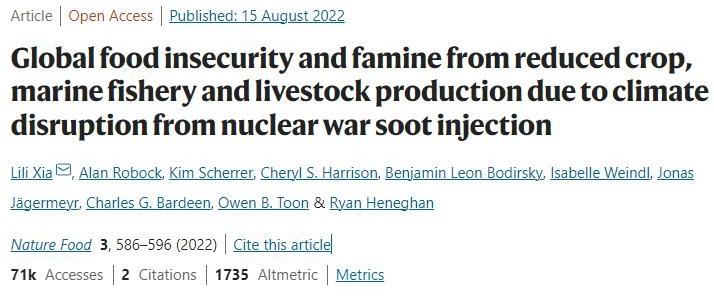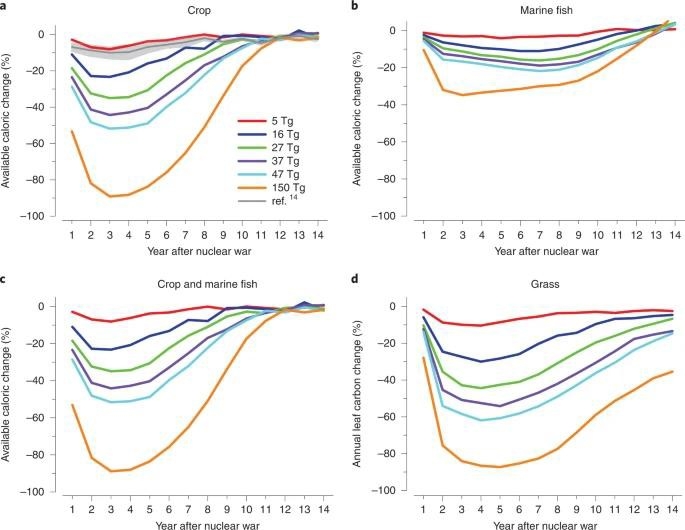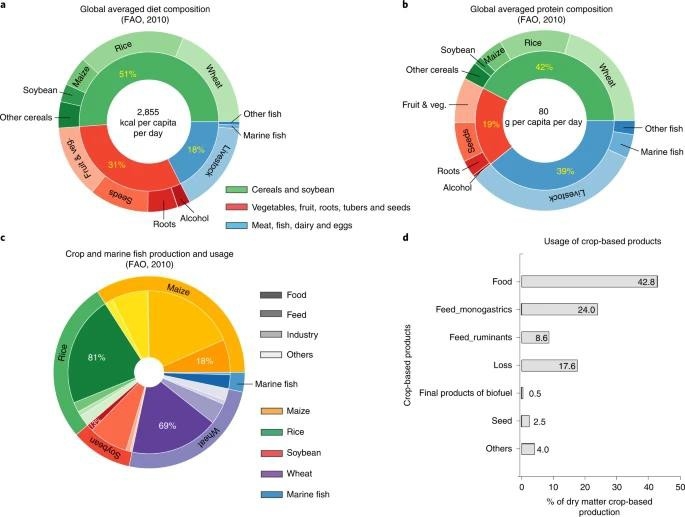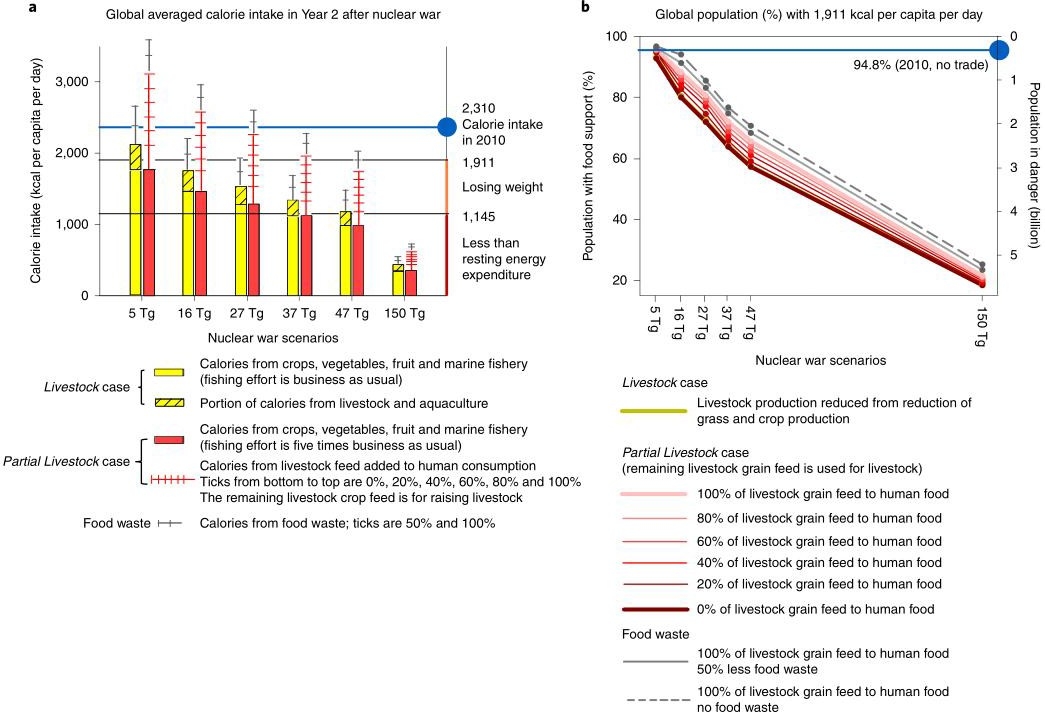2022 年 8 月 15 日,来自美国罗格斯大学、挪威卑尔根大学、德国波茨坦气候影响研究所等研究机构的 10 位研究人员在国际顶级期刊《Nature Food》上在线发表了一篇名为“Global food insecurity and famine from reduced crop, marine fishery and livestock production due to climate disruption from nuclear war soot injection”的研究论文, 文章的中文译名是《由于核战争烟尘注入造成气候破坏,作物、海洋渔业和牲畜产量减少, 导致全球粮食不安全和饥荒》。
On August 15, 2022, 10 researchers from scientific research institutes like Rutgers University, University of Bergen and Potsdam Institute for Climate Impact Research have published a paper online entitled “Global food insecurity and famine from reduced crop, marine fishery and livestock production due to climate disruption from nuclear war soot injection” in Nature Food.

在核战争中,以城市和工业区为目标的核爆将引发风暴,向高层大气注入大量烟灰,这些烟尘将在全球范围内扩散,并使地表温度迅速降低,限制粮食生产。迄今为止,各种战争情景下陆地和海洋粮食生产受到的影响少有评估。对此,文章的主要作者 Lili Xia 等人探讨了核武器使用情景下平流层烟尘喷射对世界粮食安全的影响。尽管作者们没有深入研究核战争可能如何演变或该地区如何被消灭,但他们回答了新的挑战性问题,即在核打击后的几年里,国家和全球粮食安全会发生什么?
In a nuclear war, bombs targeted on cities and industrial areas would start firestorms, injecting large amounts of soot into the upper atmosphere, which would spread globally and rapidly cool the planet, limiting the food production. So far, an integrated estimate of the impacts of the entire range of war scenarios on both land- and ocean-based food production is missing. Therefore, Lili Xia and other researchers explore the impact of nuclear war soot injection on world food security. Although the researchers do not delve into how a nuclear war might evolve or be wiped out in a region, they answer the new and challenging question of what happens to national and global food security in the years following a nuclear war?

核战争将主要污染使用核武器的地点附近的土壤和水,而烟尘一旦到达高层大气就会在全球 范围内扩散;因此,无论交战国如何,结果都具有全球相关性。表 1 研究了六种持续一周的核战争情景(产生 5 Tg 至 150 Tg 的烟尘)对食物供应的影响,罗列出城市目标上的武器数量、当量、爆炸造成的直接死亡人数以及由此造成的因饥荒而死亡的人数:超过 20 亿人可能死于印度和巴基斯坦之间的核战争,超过 50 亿人可能死于美国和俄罗斯之间的战争,这凸显了全球合作在防止核战争方面的重要性。
Nuclear war would primarily contaminate soil and water close to where nuclear weapons were used. Soot disperses globally once it reaches the upper atmosphere; thus, our results are globally relevant regardless of the warring nations. The researchers examine the impacts of six war scenarios in Table 1, generating 5 Tg to 150 Tg of soot, on the food supply. Table 1 shows the number of weapons on urban targets, yields, direct fatalities from the bomb blasts and resulting number of people in danger of death due to famine for the different scenarios we studied. The researchers estimate more than 2 billion people could die from nuclear war between India and Pakistan, and more than 5 billion could die from a war between the United States and Russia—underlining the importance of global cooperation in preventing nuclear war.

文章重点关注核战争造成的气候破坏,这将影响陆地和海洋的全球粮食生产系统。作者通过 气候、作物和渔业模型计算了每年在六种不同核战争烟尘注入平流层烟尘之后一年的气候影 响。气候影响将持续约十年,但将在最初的几年达到峰值,海洋净初级生产力(海洋食物网 的基础)的减少是适度的(从 5 Tg 中的 3%到 150 Tg 中的 37%),并且不会引起海洋温度的明显变化。
The researchers focus on the climate disruption from nuclear war, which would impact global food production systems on land and in the oceans. Using climate, crop and fishery models, the researchers calculate calorie production for different food groups, for each year after a range of six different stratospheric soot injections. The climatic impacts would last for about a decade but would peak in the first few years. Reduction in oceanic net primary productivity—the base of the marine food web—is moderate (from 3% in 5 Tg to 37% in 150 Tg), and ocean temperature changes are less pronounced.

作者使用主要作物和野生捕获的海洋鱼类的模型模拟以及其他食品和畜牧业生产的预期变化来评估对全球卡路里供应的影响。图 2 显示即使在最小的 5 Tg 烟尘情景下,模拟的作物的全球平均卡路里产量在战后 1-5 年也下降了 7%,而在 150 Tg 烟尘的情况下,全球作物的平均卡路里产量将在核战争后 3-4 年减少约 90%。这些变化将引起全球粮食市场的灾难性破坏,因为与对照模拟相比,即使全球产量下降 7%,也将超过自 1961 年国际粮农组织(FAO) 的观测记录
The researchers use model simulations of major crops and wild-caught marine fish together with estimated changes in other food and livestock production to assess the impacts on global calorie supply. Global average calorie production from the crops we simulated decreased 7% in years 1–5 after the war even under the smallest, 5 Tg soot scenario (Fig. 2). In the 150 Tg soot case, global average calorie production from crops would decrease by around 90% 3–4 years after the nuclear war. The changes would induce a catastrophic disruption of global food markets, as even a 7% global yield decline compared with the control simulation would exceed the largest anomaly ever recorded since the beginning of Food and Agricultural Organization (FAO) observational records in 1961.

为了估计对人类消费的食物总卡路里的影响,作者考虑了饮食成分,不同食物类型的卡路里含量,作物使用情况以及没有直接建模的食品生产变化。图 3 显示了全球平均人类饮食和蛋白质组成以及作物产品使用:陆地作物产量在作物和渔业的总卡路里变化中占主导地位,而主食作物每单位零售质量所含的卡路里大约是鱼类的五倍。海洋野生捕捞渔业占总卡路里的0.5%,但占全球平均蛋白质供应量的 3.5%。
To estimate the effect on the total food calories available for human consumption, researchers consider diet composition, calorie content of different food types, crop usage and changes in food production that they did not directly model. Fig. 3 shows the global average human diet and protein composition and usage of crop-based products. Terrestrial crop production dominates the total calorie change of crops and fisheries combined, and staple crops contain around five times more calories than fish per unit retail mass. In total, marine wild capture fisheries contribute 0.5% of total calories but 3.5% of global average protein supply.

图 4 显示了不同核战争烟尘注入后第 2 年的食物摄入量,卡路里损失的国家主要归咎于休耕地的数量,区域气候影响,人口水平以及假设国际粮食贸易完全停止。5 Tg 烟尘注入,大多数国家显示相对于 2010 年水平的卡路里摄入量减少,但仍然足以维持体重,随着较大的烟尘注入,大多数中高纬度国家在畜牧业基本保存的情况下仍发生严重饥饿。
Fig. 4 shows the food intake (kcal per capita per day) in Year 2 after different nuclear war soot injections. National consequences of calorie loss depend on the amount of fallow cropland, regional climate impacts, population levels and assuming a complete halt of international food trade. With a 5 Tg injection, most nations show decreasing calorie intake relative to the 2010 level but still sufficient to maintain weight. With larger soot-injection cases, severe starvation occurs in most of the mid–high latitude nations under the livestock case.

图 5 显示,通过贸易可以在一定程度上克服战后区域性的卡路里平均供应量极端减少,但全球粮食的平等分配可能是一个重大挑战。在 5 Tg 情景下,每个人都有足够的食物来支持他们的正常身体活动; 而在150 Tg 的情况下,大多数国家在第2 年年底前存活的人口不到25%。总而言之,核战争后光线减少、全球降温以及可能的贸易限制将是一场全球粮食安全灾难。气候扰动对作物总产量的负面影响通常不能被牲畜和水生食品的供应抵消。
The global average calorie supply post-war (Fig. 5a) implies that extreme regional reductions (Fig. 4) could be overcome to some extent through trade—but equal distribution of food globally would probably be a major challenge. There would be enough food for everyone under the 5 Tg scenario to support their normal physical activity, but under the 150 Tg case, most countries would have less than 25% of the population survive by the end of Year 2. In conclusion, the reduced light, global cooling and likely trade restrictions after nuclear wars would be a global catastrophe for food security. The negative impact of climate perturbations on the total crop production can generally not be offset by livestock and aquatic food
参考文献:https://www.nature.com/articles/s43016-022-00573-0
 公众号
公众号